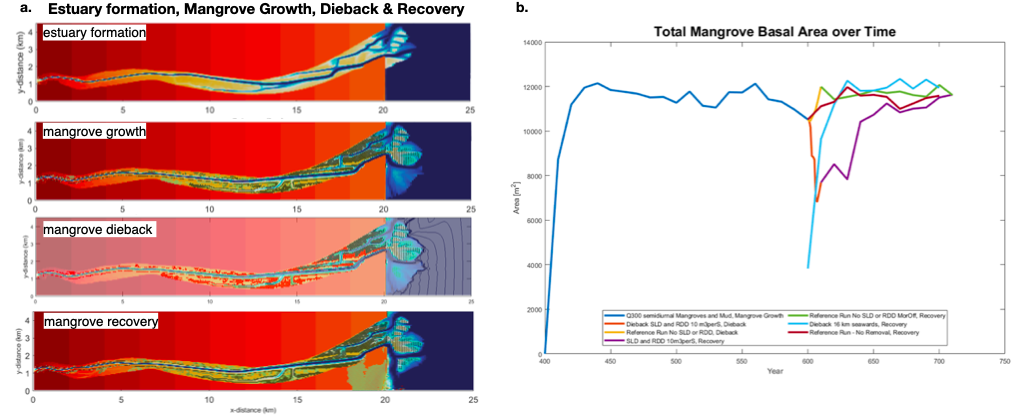S. Dzimballa1*, D. Xie1, B. Van Maanen2, M. G. Kleinhans1
1 Utrecht University, Department of Physical Geography
2 University of Exeter
*corresponding author: This email address is being protected from spambots. You need JavaScript enabled to view it.
Introduction
Mangrove forests are valuable ecosystems, but in rapid decline due to various threats such as extreme climate events and sea level rise. One recent example of a large-scale mangrove dieback event in the Gulf of Carpentaria, Australia has raised great concerns in society while its causes and consequences remain poorly studied (Duke et al., 2017). To understand the impacts of such dieback events and assess mangrove tree recovery, the bio-geomorphological feedbacks between mangrove dynamics and the estuarine morpho- and hydrodynamics is unraveled using simulations with a bio-morphodynamic model.
Methods
A bio-morphodynamic model (Xie et al., 2020) was used to simulate the settling, growth and mortality of mangrove trees dependent on inundation and competition. The effects of tides, river discharge, sand and mud conditions in Delft3D runs resemble the Leichhardt estuary in the Gulf of Carpentaria. The simulations are based on four phases including processes of the estuary development, mangrove establishment, dieback due to a decrease in sea level & river discharge, and mangrove recovery (Fig. 1).
Results
The results show that mangrove dieback can be triggered by a sea level drop and river discharge decrease. The mangrove dieback has effects on the morphology and hydrodynamics of the estuary: the absence of vegetation leads to channel infilling, decreased sedimentation in the previously vegetated areas and increased flow velocity in the vegetation loss areas (Fig. 1a). The simulations also suggest that the recovery of the mangrove tree distribution is slow (Fig. 1b). Considering the likelihood of further disturbance events, a full recovery within the life cycle of mangrove trees seems unlikely.

Figure 1: Mangrove behaviours during dieback and recovery processes. a) Bio-morphodynamic model simulations in 4 phases, b) mangrove basal area over three phases.
References
Duke, N. C., Kovacs, J. M., Griffiths, A. D., Preece, L., Hill, D. J. E., Van Oosterzee, P., Mackenzie, J., Morning, H. S., & Burrows, D. (2017). Large-scale dieback of mangroves in Australia's Gulf of Carpentaria: A severe ecosystem response, coincidental with an unusually extreme weather event. Marine and Freshwater Research, 68(10), 1816–1829.
Xie, D., Schwarz, C., Brückner, M. Z. M., Kleinhans, M. G., Urrego, D. H., Zhou, Z., & van Maanen, B. (2020). Mangrove diversity loss under sea-level rise triggered by bio-morphodynamic feedbacks and anthropogenic pressures. Environmental Research Letters, 15(11).










